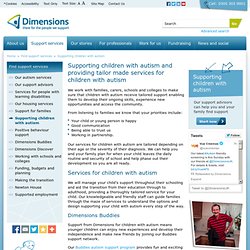

Visual supports. Visual supports can be used to help people with an autism spectrum disorder (ASD).

They are adaptable, portable and can be used in most situations. We see and use visual prompts every day, for example road signs, maps and shopping lists. They help us to function, to understand the world around us, and provide us with valuable information. Many people with an ASD are thought to be visual learners, so presenting information in a visual way can help to encourage and support people's communication, language development and ability to process information. It can also promote independence, build confidence and raise self-esteem. This page contains lots of illustrations, so we have made it available as a PDF for optimum formatting, especially if you wish to print it: Visual supports (PDF) Quick link to this page: www.autism.org.uk/24388. Strategies and approaches. Helping Children with Autism: Treatment Strategies and Parenting Tips. A parent’s guide to autism treatment and support If you've recently learned that your child has or might have an autism spectrum disorder, you're probably wondering and worrying about what comes next.

No parent is ever prepared to hear that a child is anything other than happy and healthy, and a diagnosis of autism can be particularly frightening. You may be unsure about how to best help your child or confused by conflicting treatment advice. Or you may have been told that autism is an incurable, lifelong condition, leaving you concerned that nothing you do will make a difference. Strategies and Solutions. Strategies to Support Successful Communication There are several communication strategies that are commonly used for individuals with autism.

Research supports the fact that augmentative communication strategies have been successful in helping individuals with autism: Increase functional communication skills Decrease challenging behaviors Increase language and literacy skills. Login.seam?ERIGHTS_TARGET=http%3A%2F%2Fpsycnet.apa. General_Strategies. About Us. This site uses cookies to store information on your computer.

Some cookies on this site are essential, and the site won't work as expected without them. These cookies are set when you submit a form, use the site shop or interact with the site by doing something that goes beyond clicking on simple links. We also use some non-essential cookies to anonymously track visitors or enhance your experience of the site. If you're not happy with this you may switch the cookies off, but note that some features of the site (e.g. the website shop) may not work as expected. By using our site you accept the terms of our Privacy Policy. (One cookie will be set to store your preference) (Ticking this sets a cookie to hide this popup if you then hit close. Supporting children with autism. We work with families, carers, schools and colleges to make sure that children with autism receive tailored support enabling them to develop their ongoing skills, experience new opportunities and access the community.

From listening to families we know that your priorities include: Your child or young person is happy Good communication Being able to trust us Working in partnership. Our services for children with autism are tailored depending on their age or the severity of their diagnosis. We can help you and your family plan for when your child leaves the daily routine and security of school and help phase out their development so you are all ready. We will manage your child’s support throughout their schooling and aid the transition from their education through to adulthood, providing a thoroughly tailored service for your child. Dimensions Buddies. .. Positive Partnerships Online Learning Portal. Autism is a complex developmental disability that affects how an individual thinks, learns and experiences the world.

All children with autism are different but they share difficulties in five core areas. These include: Successfully supporting a child with an ASD involves understanding the unique way the characteristics present in the child and how these characteristics impact on his/her life at home, school and in the community. Strategies need to be individually tailored based on this understanding – a one-size fits all approach is not helpful. Click on the sub menu to the left to explore:
Education: classroom and playground - support for children with autism spectrum disorders. A few facts about autism - Live Well. Autism is a serious and lifelong developmental disability.

On its own, autism is not a learning disability or a mental health problem. However, some people with autism have an accompanying learning disability, learning difficulty or mental health problem. Autism is a spectrum condition. This means that while all people with autism share certain difficulties, the condition affects them differently. Perhaps the best known form of autism is Asperger syndrome. Parents-guide-children-special-educational-needs. Supporting Children with Autism in Mainstream Schools - Diana Seach, Michele Lloyd, Miranda Preston.
How Students With Autism Learn. To understand how children with autism learn, one must be cognizant of the core deficits that define autism and impede the development of the fundamental prerequisite skills essential for learning.

How To Help A Child With Autism Learn More Effectively. Drug shows promise in kids with autism, researchers say. Building on what they hope will be an important insight into the cause of autism, French researchers are testing a high blood pressure medication on dozens of European children with autism.

The team, which has a financial stake in the drug, has tried it on 30 children with autism; now they are testing it in more, hoping to improve core characteristics of autism for the first time. There are drugs to treat some of autism's symptoms, but none that address the underlying social and communication difficulties and repetitive behaviors, which define the condition.
Previous attempts to develop an effective drug against the condition, which affects at least one in 88 U.S. schoolchildren, have either failed or are also still experimental. In a study out today in the journal Science, the researchers offer an explanation for the promise of their drug, bumetanide, a generic diuretic long used to treat the fluid retention of high blood pressure. New-insights-into-the-mystery-of-autism-could-it-be-caused-at-birth-by-salt-in-the-nerves-9112720. Scientists believe that high concentrations of chloride – the negatively charged salt ion found naturally within nerve cells – could be responsible for tipping the brain of a newborn child on the path towards autistic development.

Autism affects about one per cent of people and is a lifelong development disorder that begins in early childhood and affects how sufferers communicate and interact with other people. The spectrum of symptoms can range from relatively mild to very severe. The origins of autism are not understood but in a series of ground-breaking experiments on mice, researchers believe they have found evidence to show how autism results from a failure to quickly lower levels of chloride ions within the neurons of the brain during birth.
Chloride ions are kept deliberately high in the neurons of the foetus while developing in the womb. Oxytocin acts like a diuretic, reducing chloride levels within the neurons. Case study: Nick Gilling. Causes. There is no known single cause for autism, but it is generally accepted that it is caused by abnormalities in brain structure or function. Brain scans show differences in the shape and structure of the brain in children with autism versus in neurotypical children. Researchers are investigating a number of theories, including the links among heredity, genetics and medical problems.
In many families, there appears to be a pattern of autism or related disabilities, further supporting the theory that the disorder has a genetic basis. Landrigan-what-causes-autism. What are the causes and is there a 'cure'?